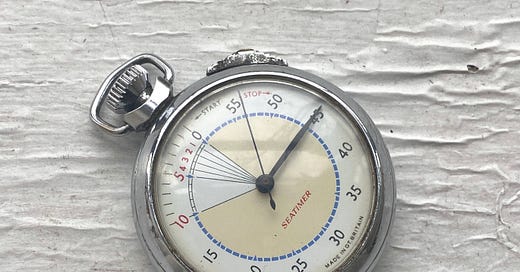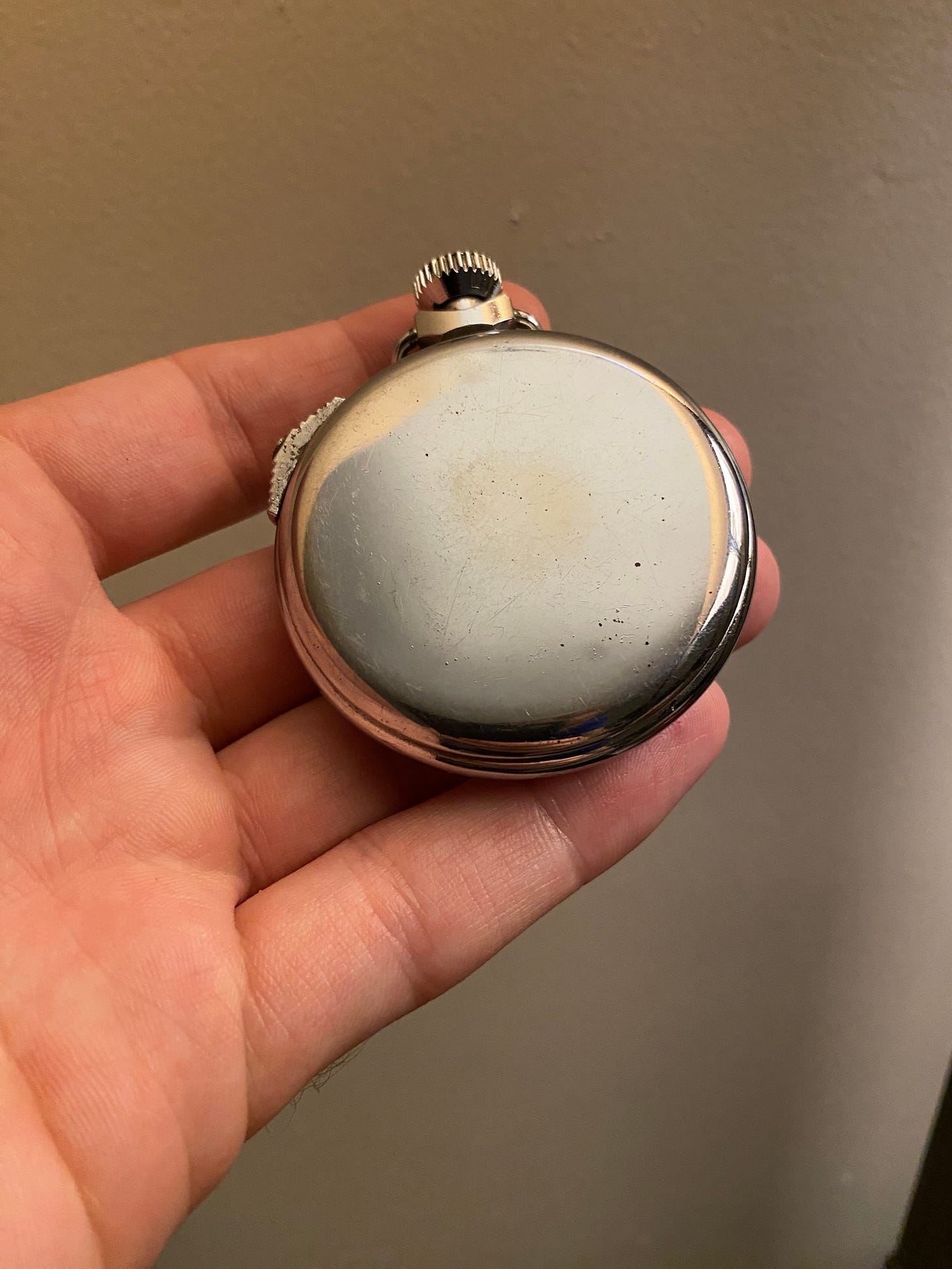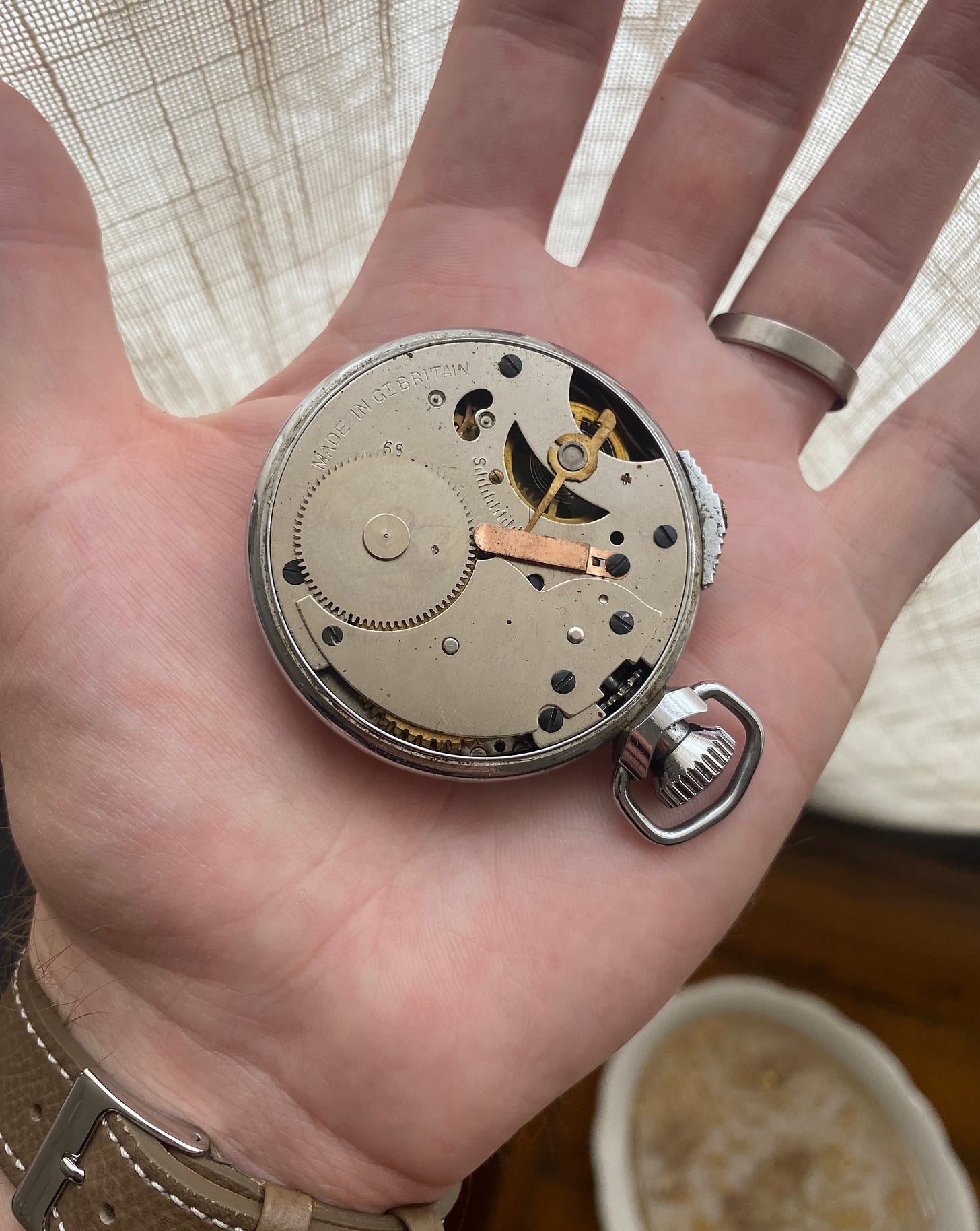Ingersoll Watch Company is one of many watch and clock brands to have started their trade in the United States, fallen apart along the way, and then been bought out for overseas ownership and production. Having technically started in New York City in the 1880s, the first watches that the company produced (in tandem with a company from Connecticut, the Waterbury Clock Company…remember that for later) came in 1892, hence that year being on the Ingersoll logo still today. What followed would be a slightly complicated journey of buying up other floundering watchmaking companies, expanding, becoming a massive American watchmaking brand producing millions of units per year (most famously for the dollar watch which was a watch that cost, yes, a dollar), being the official (ish) timepiece producer for Ghandi (yes, seriously, the man was a fan), creating the first pocket watch to glow in the dark (big audience with WW1 tank crews), abruptly going bankrupt after WW1 during the recession…
*inhales deeply*
…being bought by the Waterbury Clock Company (which would later become Timex but keep the Waterbury name alive through, you guessed it, the Timex Waterbury line), being sold to the WCC board of directors in London, joining with/being semi-acquired by (depends on who you ask as to how even split that was) Smiths Industries/the Smiths Group (take a minute to check this out if you’ve not heard of them before), bopping in and out of projects and random productions, producing watches in the U.S, then in Great Britain, focusing heavily on character watches such as the Mickey Mouse watch to the point where it became more or less exclusively what the brand was known for…
*inhales deeply again*
…being sold again and bought again and then finally sold again to the current owners, Zeon Watches, which is technically based in Hong Kong because that’s the home base of their parent company, Herald Holdings Ltd., but, also technically, it’s ownership that is classified local due to the owning subsidiary being British…kinda…well…their office is in Bermuda, which does its own thing but is a British territory. The brand was effectively relaunched in 2016 and has Timex back on board as a distributing partner.
For this installment of Discovering Watch History, we’re focusing on an undated, uncatalogued, unbranded Ingersoll Seatimer, which is a regatta yacht timer much in the style of old racing stopwatches. Regatta timers were/are a type of stop watch that counts down in various intervals, typically in 1-5 minutes or so. For this timer in particular, the dial is laid out to be able to count down from an hour, with more detail given to the 5 minute and under markers; this is because of the increased importance of the 5 minutes leading up to the start of the regatta.
Here’s a useful excerpt from Everest on this countdown use:
The starting procedure of a sailing race involves a series of flags and horns, but in essence, it is a 5-minute countdown (in some rarer instances 10 minutes). For that reason, most regatta timers have timing countdowns of five minutes or increments of five. Here is the breakdown of a start:
5 minutes to start: A flag and horn to signal the start of the countdown. Engage your regatta timer on a five minute countdown.
4 minutes to start: A second flag and horn sounds. This is both a second timing reminder as well as a flag displaying starting rules of the race. If one didn’t start their 5-minute countdown, they can begin a 4-minute countdown now.
1 minute to start: Flag change and final preparatory signal.
0 minutes to start: Starting flag and signal.
As a member of a sailing crew is likely extremely busy both positioning for a start as well as navigating around other yachts, most regatta timers are designed with high visibility in mind. Looking at both current production and vintage timers, you are likely to see high-visibility color combinations.
As you can see on the Seatimer, the countdown section from 10-0 is both a separate color from the rest of the numerals and more detailed with regards to its included numerals and hash marks.
Winding the crown is the same as with a watch, but where it gets interesting is that the crown can be pushed in and turned simultaneously to adjust the point from which the timer will begin its countdown. To the right of the crown is the start/stop switch, with a toggle left starting the timer, and a toggle right pausing/stopping it. I’ve found that after what has probably been a pretty significant amount of use over the years, it still keeps pretty good time, if anything maybe just a tad slow. And while you won’t catch me at an actual regatta anytime soon, you can bet that I would bring something like this along with me if I were more in tune with nautical racing (spoiler: it’s an expensive hobby/sport, and I’ve got diapers to buy for a four month-old).
When it comes to the production time period of the Seatimer, it’s a bit unclear. There are no specific production identifiers on the case, dial, caseback, or movement, and Ingersoll doesn’t keep or publish archived products past recent launches. There is a small “68” stamped on the inside of the timer, underneath “MADE IN GT BRITAIN” and not really doing a great job at standing out; there’s a chance that this is the manufacture date of that particular component, or even of the entire timer, but the lack of actual archival information held by Ingersoll makes it difficult to say for certain. They do have an abbreviated history on their website, but the chunk missing (1958-2011) is where our Seatimer would have likely been produced, given the timing of Ingersoll having moved to Great Britain, the rise of popularity for handheld regatta timers in the 60s and 70s, and the product transition that occurred for the company from clocks/timing devices to more wristwatches.
While an official archive from the brand isn’t available, I was able to find a sibling of the Seatimer - the Yachtsman - in an antique listing.
In fact, the Yachtsman is really how I initially determined that the Seatimer was from Ingersoll, given how the two look to be made out of the same production series.
Now these antique sale types of listings aren’t always the most reliable, but in this one in particular, the timer actually came with its original box and guarantee dated 1965. I was also able to find a listing catalog with a ton of regatta timers, which placed the Seatimer and the Yachtsman right in line with each other and showed just how close they were in aesthetic design.
Interestingly, The British Museum has an archive for the Ingersoll Yachtsman, and in fact one example was donated in 1983, but besides the measurements, movement details, and donating party/date, it’s not the most informative of listings.
To assign this Seatimer a production period, I’m going to lean heavily on what we know and what was found about the Yachtsman in addition to the low hanging fruit that is the “68” within the Seatimer. The design language to the one with the 1965 paperwork is nearly identical, and the odds of this timer being released in any batch size separate from the Yachtsman are low; the only exceptions would likely be a limited run just before or just after production halted for the Yachtsman, maybe in an effort to either introduce or expand upon the line, which still would put the Seatimer as an early 60s to early 70s production piece. I would then eliminate the early 70s as a reasonable possibility because Ingersoll detached itself from Smiths and their joint British watchmaking operation in 1969; while it’s entirely possible that more watches were produced in Great Britain by Ingersoll after this date, it would have been done without the same factory resources, and this is a continuation of that undefined, somewhat murky historical period for the brand. The quartz crises loomed, and in the 70s and 80s those quartz pieces are largely what Ingersoll produced in an effort to stay afloat, so the odds of the Seatimer being produced at a time when the brand had split off to make more quartz are the lowest yet.
Bearing all that in mind, I’m putting the Seatimer production window between 1963-68, with ‘67-68 the most likely specific year if we’re to go off of the movement stamp. Again, there’s no way to know for certain that this is what that numeric stamp means, but it’s hard to imagine that it would be something like, say, a serial number. That would be incredibly low and probably a bit more of a value-add.
While the brand doesn’t produce pieces like the Seatimer or Yachtsman anymore, Ingersoll is pretty widely distributed still today, and they have an interesting variety of watches available - though naming one of their watches “The Baller” wouldn’t have been in my top set of marketing ideas. It’s a completely different type of company now than it was a hundred years ago, which makes sense, that happens, but does leave a bit to the imagination of what it might’ve looked like today had the ownership remained a bit more constant. Nowadays, because of their ownership, the vast majority of their watches are produced in China and then distributed worldwide. While there are some interesting designs as I noted, most of the offerings are large, skeletonized homages to watches like the Cartier Santos, Patek Phillipe Nautilus, various Richard Mille references, and generic Gerald Genta designs. Many are 43-46 mm, which is sizeable, and it’s fair to draw comparisons to watches sold by, say, Invicta, or late night TV commercial product channels. They may be to someone’s taste, but being not a huge fan of skeletonized watches, nor homages, they’re not for me. And while I know that there are examples of movements and watches made in China being able to carry a higher production quality now than 10-15 years ago, I can’t help but feel a sense of disappointment in where the brand is now compared to where it was when this Seatimer was produced.
As always, wherever you are, and wherever you’re going, many thanks for stopping by.








